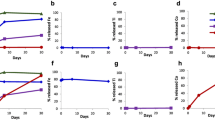Abstract
This report describes the second year of long-term continuous exposures of female NAMRU mice to small air ions and D.C. electric fields in the following conditions: ± high ions ((2×105/cm3), ± low ions (2×103/cm3), ± field (2 kV/m) only and ground (ion depleted, no field). Using an isolated anesthesized mouse, whole body ion flux values averaged 1.04±0.63×10−10 A in high ion cages for different positions on the cage floor, with about a hundred-fold reduction for low ion cages.
During the second year (sample periods 5–8) of exposure serum chemistry variability increased, due to increased pathology and decreased numbers of animals as our experimental population died off. The fifth sample period yielded results consistent with those seen earlier, but later sample periods had many fewer significant differences between cages than did those of the first year. Nevertheless, MCA statistics for serum glucose for the second year found a pattern remarkably similar to the first, with the low ion cages (LN and LP) having the lowest levels. MCA statistics for both years emphasized this possible “window” effect of low level ionized conditions. Also, a comparison between the combined values for ionized (HN, LN, HP and LP) and ion depleted cages (NF, PF, G1 and G2) showed a highly significant difference (p<10−6) for serum glucose for both years of exposure, with lower glucose values seen for animals in the ionized cages overall. Animals of all conditions also showed a highly significant decrease in serum glucose with age.
Comparison of mice in ionized cages vs. the non-ionized cages also resulted in a significant difference (p<.013) for survival characteristics between groups, with ion exposed animals having a shorter lifespan. These statistics argue strongly for significant effects of long-term exposure of NAMRU mice to the ionized environment.
Similar content being viewed by others
References
BECKER, R. O. and MARINO, A. A. (1982): Electromagnetism and Life, State University of New York Press, Albany.
DIAMOND, M. C., CONNOR, J. R., ORENBERG, E., BISSELL, M., YOST, M. and KRUEGER, A. P. (1980): Environmental Influences on Serotonin and Cyclic Nucleotides in Rat Cerebral Cortex. Science, 210: 652–654.
KAPLAN, E. L. and MEIER, P. (1958): Nonparametric Estimation from Incomplete Observations. J. Amer. Stat. Assoc., 53: 457–481.
KELLOGG, E. W. III (1984): Air Ions: Their Possible Biological Significance and Effects. J. Bioelec., May issue.
KELLOGG, E. W. III, YOST, M. G., REED, E. J. and KRUEGER, A. P. (1985): Long-Term Biological Effects of Air Ions and D.C. Electric Fields on NAMRU Mice: First Year Report. Int. J. Biometeor., 29: 253–268.
KRUEGER, A. P., KOTAKA, S. and ANDRIESE, P. C. (1962): Some Observations on the Physiological Effects of Gaseous Ions. Int. J. Biometeor., 6: 33–48.
KRUEGER, A. P., ANDRIESE, P. C. and KOTAKA, S. (1963): The Biological Mechanism of Air Ion Action: The Effect of CO+ 2 in Inhaled Air on the Blood Level of 5-Hydroxytryptamine in Mice. Int. J. Biometeor., 7: 3–16.
KRUEGER, A. P., KOTAKA, S., NISHIZAWA, K., KOGURE, Y., TAKENOBU, M. and ANDRIESE, P. C. (1966): Air Ion Effects on the Growth of the Silkworm (Bombyx mori L.). Int. J. Biometeor., 10: 29–38.
KRUEGER, A. P. (1982): Air Ions as Biological Agents — Fact or Fancy?, Part I and Part II. Imm. and Allergy Prac., IV: 129–140, 173–183.
LEE, E. and DESU, M. (1972): A Computer Program for Comparing K Samples with Right-Censored Data. Computer Programs in Biomedicine, 2: 315–321.
POHL, H. and TODD, G. W. (1981): Electroculture for Crop Enhancement by Air Ions. Int. J. Biometeor., 25: 209–221.
YAMAGUCHI, F. M. and KRUEGER, A. P. (1983): Electroculture of Tomato Plants in a Commercial Hydrophonics Greenhouse. J. Biol. Phy., 11: 5–10.
YOST, M. G. (1979): Air Ions as a Mediator in Animal Behavior Prior to Earthquakes. U.S. Geological Survey, Open File Report on Animal Behavior Prior to Earthquakes. Conference II, October 18–19, Galveston, Texas.
Author information
Authors and Affiliations
Rights and permissions
About this article
Cite this article
Kellogg, E.W., Yost, M.G., Reed, E.J. et al. Long-term biological effects of air ions and D.C. electric fields on Namru mice: Second year report. Int J Biometeorol 29, 269–283 (1985). https://doi.org/10.1007/BF02189658
Received:
Revised:
Issue Date:
DOI: https://doi.org/10.1007/BF02189658




